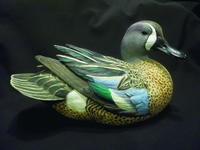Blue-Winged Teal Drake Painting
As the name indicates, color is important with this waterfowl.

The blue-winged drake is fun to paint. It gives you many opportunities to experiment and develop your own techniques, because you can use a variety of painting systems, including airbrushing, wet blending, washes, and dry brushing.
For me, a good airbrush is critical for this project. The Paasche AB was my choice. I used it extensively to create depth and intensity on the chest and side pocket markings, shadows and accents on the face, and softness on the tertials and scapulars. I also used washes and dry brushing to adjust color values and add richness and highlights throughout.
I will provide good ways to achieve the colors that I see on the blue-winged drake but you might have a different impression as to what the bird looks like. When you paint, what you see is not necessarily what someone else does. This was sound advice that I received many years ago. Do not be afraid to experiment with colors. Create your own mixes from these guidelines and have fun.
Read the complete article in Wildfowl Carving Magazine's Winter 2013 issue.
Read NextDemonstration: Carver's Block



